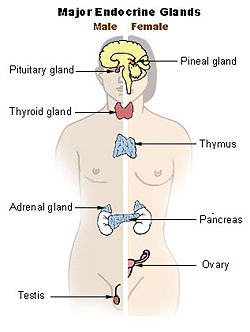Adrenal gland
| Adrenal gland | |
|---|---|
 |
|
| Endocrine system | |
 |
|
| Adrenal gland | |
| Latin | glandula suprarenalis |
| Gray's | subject #277 1278 |
| System | Endocrine |
| Artery | superior suprarenal artery, middle suprarenal artery, Inferior suprarenal artery |
| Vein | suprarenal veins |
| Nerve | celiac plexus, renal plexus |
| Lymph | lumbar glands |
| MeSH | Adrenal+Glands |
| Dorlands/Elsevier | Adrenal gland |
In mammals, the adrenal glands (also known as suprarenal glands) are the star-shaped endocrine glands that sit on top of the kidneys; their name indicates that position (ad-, "near" or "at" + renes, "kidneys"; and as concerns supra-, meaning "above"). They are chiefly responsible for regulating the stress response through the synthesis of corticosteroids and catecholamines, including cortisol and adrenaline.
Contents |
Anatomy and function
Anatomically, the adrenal glands are located in the thoracic abdomen situated atop the kidneys, specifically on their anterosuperior aspect. They are also surrounded by the adipose capsule and the renal fascia. In humans, the adrenal glands are found at the level of the 12th thoracic vertebra and receive their blood supply from the adrenal arteries.
The adrenal gland is separated into two distinct structures, both of which receive regulatory input from the nervous system:
Adrenal medulla
The adrenal medulla is the central core of the adrenal gland, surrounded by the adrenal cortex. The chromaffin cells of the medulla are the body's main source of the catecholamine hormones adrenaline (epinephrine) and noradrenaline (norepinephrine). These water-soluble hormones, derived from the amino acid tyrosine, are part of the fight-or-flight response initiated by the sympathetic nervous system. The adrenal medulla can be considered specialized ganglia of the sympathetic nervous system, lacking distinct synapses, instead releasing secretions directly into the blood. It is also the main source of dopamine, a catecholamine closely related to adrenaline and noradrenaline.
Adrenal cortex
The adrenal cortex is devoted to the synthesis of corticosteroid hormones from cholesterol. Some cells belong to the hypothalamic-pituitary-adrenal axis and are the source of cortisol synthesis. Under normal unstressed conditions, the adrenal glands produce the equivilent of 35-40mg of cortisone acetate per day.[1] Other cortical cells produce androgens such as testosterone, while some regulate water and electrolyte concentrations by secreting aldosterone. In contrast to the direct innervation of the medulla, the cortex is regulated by neuroendocrine hormones secreted by the pituitary gland and hypothalamus, as well as by the renin-angiotensin system.
Arteries and veins
Although variations of the blood supply to the adrenal glands (and indeed the kidneys themselves) are common, there are usually three arteries that supply each adrenal gland:
- The superior suprarenal artery is provided by the inferior phrenic
- The middle suprarenal artery is provided by the abdominal aorta
- The inferior suprarenal artery is provided by the renal artery
Venous drainage of the adrenal glands is achieved via the suprarenal veins:
- The right suprarenal vein drains into the inferior vena cava
- The left suprarenal vein drains into the left renal vein or the left inferior phrenic vein.
The suprarenal veins may form anastomoses with the inferior phrenic veins.
The adrenal glands and the thyroid gland are the organs that have the greatest blood supply per gram of tissue. Up to 60 arterioles may enter each adrenal gland.[2]
See also
- Fight-or-flight response
- Stress
- Geoffrey Bourne
References
Notes
- ↑ Jefferies, William (2004). Safe uses of cortisol. Charles C. Thomas Publisher. http://books.google.com/books?id=T6JLAgAACAAJ.
- ↑ JE Skandalakis. Surgical Anatomy: The Embryologic And Anatomic Basis Of Modern Surgery (2004).
General references
- MedlinePlus Encyclopedia 002219
- Virtual Slidebox at Univ. Iowa Slide 272
- Anatomy Atlases - Microscopic Anatomy, plate 15.292 - "Adrenal Gland"
- Histology at BU 14501loa
- SUNY Labs 40:03-0105 - "Posterior Abdominal Wall: The Retroperitoneal Fat and Suprarenal Glands"
- Adrenal Gland, from Colorado State University
- Cross section at UV pembody/body8a
|
|||||||||||||||||||
|
||||||||